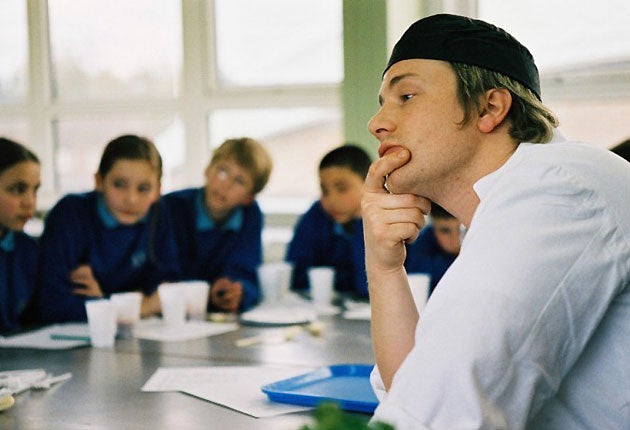Battle for healthy school food is struggling

Before TV chef Jamie Oliver's campaign to get schoolchildren eating healthily in 2005, most people had no idea what a Turkey Twizzler was. The demon foodstuff has since become synonymous with the Government's fight to wean pupils off junk food – a fight it appears to be losing.
Figures published yesterday by the School Food Trust (SFT) show that a majority of pupils are still turning up their noses at the healthy options espoused by Oliver and the Government, preferring to bring their own packed lunches or buy junk food outside the school grounds.
Only 43 per cent of primary school children are eating school dinners, a rise of just 0.1 per cent on last year. Among secondary pupils the figures are even worse, with just 36 per cent opting to eat at school, an increase of just 0.5 per cent.
The statistics mean that Government targets will be missed by a huge margin. In 2006 the Government said it wanted to increase the take-up of school dinners in England by 10 per cent by this autumn. Jim Knight, who was schools minister at the time, called it a "priority" for his department.
Yesterday, the SFT's chairwoman, Prue Leith, said Mr Knight's targets had been "totally unrealistic" and that it was impossible to "change the diet of a nation in 10 minutes".
Christine Haigh, of the Children's Food Campaign, said the figures showed that "far too many children are not yet eating a healthy lunch", and that the only way to drastically increase the number of pupils eating the meals was to offer them for free. A spokesman added that some schools had been "too casual" about marketing the new healthier options to students.
Research last year by London Metropolitan University's nutrition policy unit found that large numbers of children were still buying food from local shops which were high in calories and sugar.
The picture is even grimmer in Scotland, where last month it emerged that the number of secondary pupils eating school meals had fallen to its lowest level in a decade, from more than 50 per cent in 2003 to 39 per cent this year.
The drop was triggered by the Scottish Government's decision to introduce healthier menus in 2002, with pupils evidently shunning the new options in favour of buying burgers, chips and pizzas elsewhere.
The Liberal Democrats' schools spokesman, David Laws, said the Government had missed its target by "well over one million children".
He said: "The Government stands little chance of meeting its targets unless there is both more investment in the school meals service and a massive change in expectations."
In 2006, ministers banned junk food from school canteens and vending machines after Jamie Oliver's campaign gained huge public support. Chocolate, crisps, fizzy drinks and poor-quality meats were replaced with healthier options such as chicken and fish. Deep-fried foods were restricted to two portions a week.
Stricter nutritional guidelines were made compulsory in primary schools last year, with similar rules set to be introduced in secondaries this September.
In 2006, 42 per cent of primary pupils and 42 per cent of secondary pupils were eating school meals – more than today – but the SFT said the figures were not comparable due to changes in the way the statistics are collected.
Join our commenting forum
Join thought-provoking conversations, follow other Independent readers and see their replies
Comments